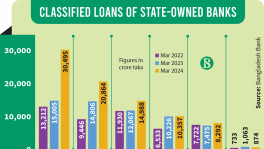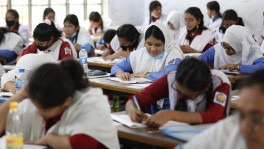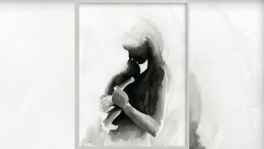A university in every 5.38 square kilometres
Dhaka tops the table for having the most universities in terms city area among the capitals of the world, with a university in every 5.38 square kilometres
If you troop down to Green Road in Dhaka on any working day, you will see hundreds of young students swarming around the street – in tea stalls, at street food corners and on the stairs of shopping malls.
Their quirky presence is one of the causes of everlasting traffic congestion in the area.
Anybody who does not know why these young people are all over the place will be quite perplexed to see them there.

But if you can locate the signboard of the Swapna Supershop on the first floor of a six-storey building, you will probably find another signboard just above it with the caption "World University of Bangladesh."
It is one of the 48 private universities in Dhaka, and has 4,570 students and 224 teachers.
At the southern and western parts of the university is LabAid Hospital, while the Hope Infertility Centre has a prominent presence to the north.
The clumsy nature of the surrounding commercial buildings offers very little scope for students to get an education in a healthy academic environment. They enter the university building for classes and come out onto the street after classes. There is no space for extracurricular activities.
Victoria University Bangladesh, another private university near the Panthapath intersection, is housed in a rented building in the middle of a busy furniture market.
They are but two examples of the poor infrastructure of the private universities in the capital.
There are 15 such private universities from Panthapath to Asad Avenue, over a distance of just 3.9 kilometres.
Conditions are much worse for many other universities. Most private universities are based in rented buildings in some of the busiest areas of the city.
The University Grants Commission lists 103 private universities in Bangladesh. Of these, 48 are in the capital alone.
Additionally, there are nine public universities in Dhaka city out of the 45 public universities in the country.
This puts Dhaka at the top of the table for having the most universities in terms city area among the capital cities of the world. Dhaka city, with an area of 360.4 square kilometres, has a university in every 5.38 square kilometres.
The number is astonishing when compared to some other major capital cities such as Delhi, Islamabad, Beijing, Kuala Lumpur, Tokyo, London, Washington DC, Ottawa and Canberra in Asia, Europe, North America and Australia.
Tokyo, seven times the size of Dhaka, ranks at the second place with 141 universities in a total area of 2,188 square kilometres. That means the city has a university in every 15.5 square kilometres.
Nadim Mahmud, a PhD researcher at Japan's Osaka University, told The Business Standard that "the number of universities in Tokyo is appropriate in terms of city area and population."
However, he believes that the number of universities in Dhaka is too high for the size of the city.
Delhi, the capital of India, has 23 universities, of which 13 are public and 10 are "deemed universities", according to information available from India's University Grants Commission.
And Delhi is about five times the size of Dhaka.
It is much the same in the Pakistani capital Islamabad, which is three times larger than Dhaka. The city has only 22 universities, out of which 15 are public and seven are private.
It should be noted that no university in Bangladesh is listed among the top 1,000 global universities in the Times Higher Education World University Rankings 2020.
The annual ranking, featuring 1,396 universities across 92 countries, was published in September this year.
Dhaka has not been in an enviable position in other areas as well. It ranks as the second-worst liveable city in the world, after Damascus in Syria, according to the annual Global Liveability Index 2019 of the Economist Intelligence Unit.
Experts say while opening new higher educational institutions is a positive move, it is equally important to maintain the quality of education and a proper academic infrastructure at these universities.
Eminent educationist Professor Serajul Islam Choudhury bluntly says, "Good teachers, research opportunities, infrastructure, etc are the indicators of quality education. But most of the private universities [in Bangladesh] cannot provide these. Under the circumstances, we do not need to open more private universities."
He noted the lack of an adequate number of senior and permanent teachers in the private universities of the country.
A report by the University Grants Commission revealed that only 10 private universities in the country have VCs, pro-VCs and treasurers.
Professor Kazi Shahidullah, chairman of the commission, said, "It is true that there is a lack of senior teachers in most private universities and newly formed public universities. But the situation will improve in a few years when lecturers attain seniority."
The UGC chairman said the commission will carefully study any proposal for a new university before it is opened.
"The decision to allow the opening of a new university comes from the education ministry. The ministry informs us after taking a decision. We cannot do anything about it," said a member of the UGC on condition of anonymity.
"In fact, the commission is not interested in opening new universities at this moment," he added.
Many private universities are reportedly functioning without meeting some of the criteria outlined in the Private University Act 2010.
Only 20 private universities in Dhaka have moved to their permanent campuses.
"Every private university has to move to a permanent campus within seven years of opening. However, they can also apply for a five year extension. We have filed a report at the education ministry against the universities that have not been moved to permanent campuses," said Jesmin Parvin, additional director (Private University) of the UGC.
Many private universities complain that they do not get any support from the government to run the institutions smoothly.
"A public university can build their infrastructure very quickly through the use of public money. But most private universities cannot move to permanent campuses because of financial constraints. Easy bank loans for land and infrastructure could help," said Sheikh Kabir Hossain, chairman of the Association of Private Universities of Bangladesh.
UGC Chairman Professor Kazi Shahidullah said, "The government will not allow a new private university to be opened in Dhaka at this moment. Land is cheaper in the suburbs of Dhaka, so private universities are moving their campuses there. Universities that are still operating in rented buildings in the city must move to their permanent campuses soon."


 Keep updated, follow The Business Standard's Google news channel
Keep updated, follow The Business Standard's Google news channel
















